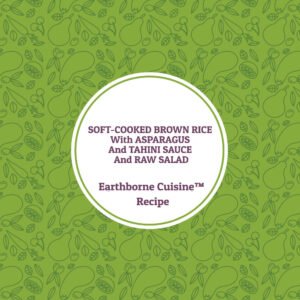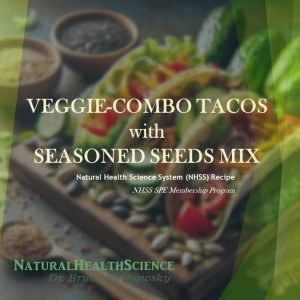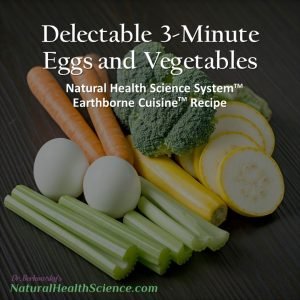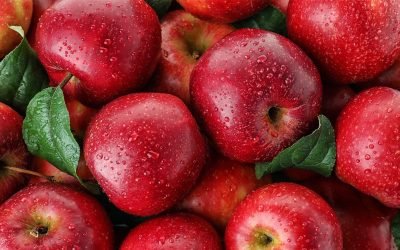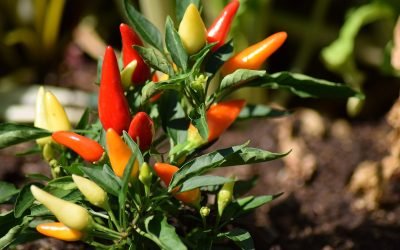Please note:
Part 1 of this discussion focused on the root causes and symptomatology of digestive derangement in general and chronic GERD (gastroesophageal acid reflux disease) in particular.
Part 2 focused on specific nature’s therapies: cool-water morning draught and post-meal water drinking, the cool sitz bath, Vital Chi Skin-Brushing followed by the Alternate Warm/Cool Shower, and an herbal chi tonic which may prove to be of good service in restoring vitality to the stomach and the rest of the digestive tract as well as in the amelioration of the tenacious, distressing symptoms of GERD.
Here in Part 3, the focus is on the therapeutic use of apples to prevent and relieve the symptoms of GERD. This article also features a much smaller discussion of almonds.
Introductory Discussion
We depend upon the digestive system to supply the trillions of bodily cells with the nutrients they require to function properly. Lacking these nutrients, every tissue of the body performs less efficiently. It should be understood that tissues are actually organized groups of cells working in unison. Organs such as the heart and kidneys are composed of tissues.
Seemingly, most people these days are suffering from one disorder or another, and even if they do not complain of digestive problems, a breakdown in the digestive process is always a factor in the development of chronic disorders.
In Digestion and Dyspepsia, R.T. Trall, M.D. writes: “We are a nation of dyspeptics and we are growing worse continually. Everyone is more or less dyspeptic now-a-days, and because everyone is ailing in this particular manner, it seems to be nobody’s business except those who make opportunity of misfortune [i.e., the drug companies]. However, [overcoming dyspepsia] should be everyone’s first order of business.”
Although it sounds as if Trall, an early American naturopath, is describing the United States of the 21st century, he actually made this observation in 1874. At that time, most people’s dietary staples came from family farms where everything was grown or raised without the use of chemical fertilizers, pesticides, herbicides, growth hormones, antibiotics and genetic engineering. Given this, it is not difficult to imagine how much worse this digestive crisis is now when a diet largely populated with adulterated and processed foods has become the norm.
Dyspepsia is a somewhat archaic medical term that refers to painful, difficult, or disturbed digestion, commonly accompanied by heartburn, flatulence and other types of stomach discomfort.
In recent years, one of the most common forms of dyspepsia has been given the name GERD, or gastroesophageal reflux disease. As is the wont of modern medicine, certain symptoms of common disorders are often regarded as stand-alone, unique ailments. In fact, GERD is a symptom of a complex network of systemic dysfunctions featuring a very prominent gastrointestinal tract component.
Defining GERD and the Lower Esophageal Sphincter
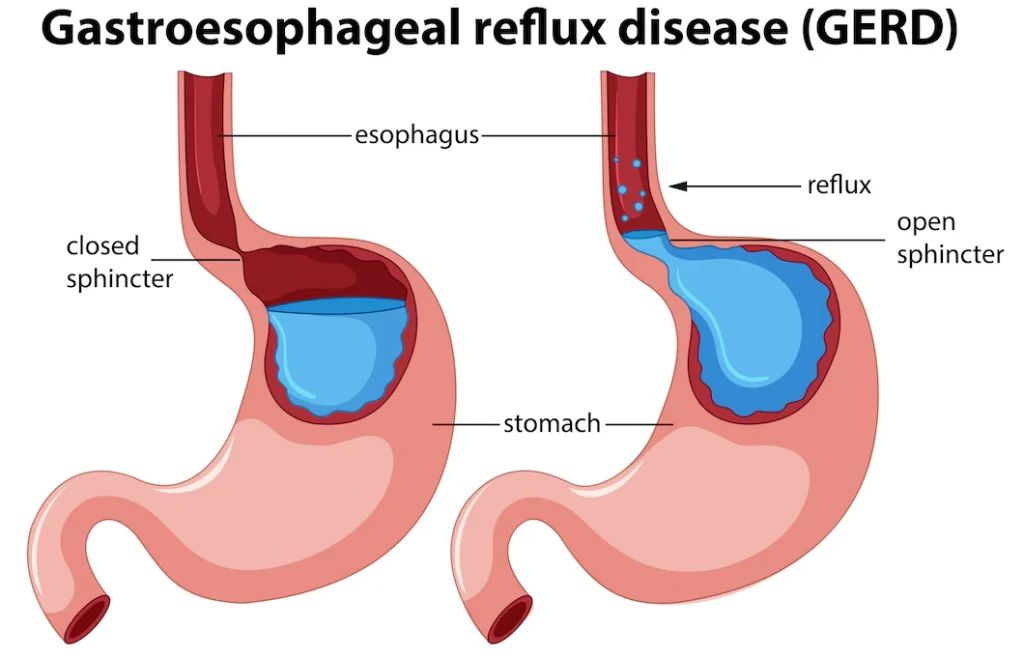
Chronic heartburn, caused by the reflux (back-flow) of stomach acid, and, occasionally, bile into the esophagus (the tube that connects the mouth to the stomach), is the most commonly noted symptom of GERD. Chronic gastroesophageal reflux (meaning from the stomach back into the esophagus) irritates, and, over time, inflames the mucosal lining of the esophagus. If this chronic irritation and inflammation are not resolved, organic changes such as narrowing of the esophagus, esophageal ulceration and even esophageal cancer may develop.
The lower esophageal sphincter (LES) is a ring of muscle that forms a valve at the lower end of the esophagus, where it joins the stomach. Normally, the LES remains closed except during swallowing, when it allows food to pass from the esophagus into the stomach, thus preventing the reflux of stomach acid up into the esophagus. Weakening or abnormal relaxation of the LES renders it unable to completely seal the connection between the stomach and esophagus, and thus, encourages the backflow of stomach acid into the esophagus. Therefore, weakness of the lower esophageal sphincter is one of the major factors in the development of GERD.
The Digestive System
The body is not comprised of a vast collection of independently operative parts. Rather, all of its functions are completely interactive and finely coordinated. Therefore, it is misleading to view GERD as being exclusively a stomach disorder. In fact, most of the symptoms associated with any disease are local expressions of generalized states.
It is virtually impossible for a digestive system disorder to be localized to one particular organ, because the digestive system consists of the mouth, esophagus, stomach, small intestine, large intestine, pancreas, liver and gall bladder–the actions of which are all orchestrated to function in concert.
Dr. Trall, one of the founding fathers of traditional naturopathy, writes: “As digestion is the most complex of all the organic processes, its derangements, which constitute indigestion, or dyspepsia, are the most complicated of all morbid conditions…It is a great mistake to regard dyspepsia as peculiarly, or especially, a disease of the stomach…We can see how essentially cooperative are a multitude of organs and structures in the digestive process. In some cases, one structure or organ will be more obstructed, impaired, or deranged than others, and in other cases, two or more will be the seat of the more troublesome symptoms.”
Trall goes on to describe the vast variety of symptoms found among those who are dyspeptic, depending upon which of the digestive organs are most deeply affected. Accordingly, stomach symptoms such as chronic acid reflux are an expression of only a fraction of the actual underlying dysfunction. Diverse symptoms such as constipation, headache, fatigue, heart palpitations and chest oppression commonly accompany pronounced symptoms of stomach distress such as GERD.
Clearly, symptoms of dyspepsia such as acid reflux are merely one aspect of a systemic pattern of dysfunction that extends far beyond the digestive system. The general loss of vitality and operational efficiency of the organism as a whole causes the digestive system to falter. Trall observes: “The debility of the stomach, or other digestive organs in any case of dyspepsia, is no greater and no worse that that of all other parts of the body. Therefore, dyspepsia is but a name for universal physical deterioration, although the symptoms of the general condition may embrace all the aches, pains and distresses our language can express.”
In turn, digestive weakness invariably initiates deterioration in every organ of the body. Digestion is the process by which foods are broken down into small molecules so that they can be efficiently assimilated into the blood and then used to nourish every cell in the body. Trall writes: “As nutrition is the first process of organic life, all other parts of the system are disproportionately debilitated when the digestive function is impaired.”
The Cause Of Chronic Acid Reflux
When seeking to understand the cause of GERD, it is important to reiterate that it is a local expression of a general state. Only after this local symptom has been contextualized, via the delineation of the general state, can the localized condition involving the esophagus, stomach, diaphragm, intestines, etc. be clearly understood and effectively addressed.
In Digestion and Dyspepsia, Trall cites the following quote excerpted from Wood’s Practice of Medicine by George B. Wood, M.D. (which at the time was a popular manual among medical doctors regarding the theory and practice of medicine): “The most specific source of dyspepsia is the combined influence of sedentary habits and errors of diet.”
Part 3 – The HUMBLE, MIGHTY APPLE
High Water-Content/High Alkaline-Reserve Diet
A fundamental dietary principle of Dr. Berkowsky’s Natural Health Science System is: Eat a diet dominated by fresh, whole, organically grown high water-content foods. A high water-content diet consists predominantly of fresh fruits and vegetables with smaller amounts of whole grains, legumes, nuts, seeds, brown eggs, fowl and fish. Ideally, every meal should emphasize water-rich foods. Fresh fruits and vegetables are rich in vitamins, minerals, fiber and organic water. When possible, use organically grown fruits and vegetables which, having been grown without pesticides, are more nutritious and do not contribute synthetic chemicals to the body’s toxic load. Remember, the body is two-thirds water, thus our “fluid organization” must be constantly nurtured and replenished.
The typical American junk-food/processed-food diet is abnormally high in protein and low in the high water-content, alkalizing fruits and vegetables. High protein-content flesh foods are powerful stressors to the acid-producing cells of the stomach, because pepsin (the protein-splitting enzyme secreted by the stomach) is most active in a strongly acidic environment.
Each time a high-protein flesh food meal is consumed, said cells are challenged to elevate their efforts beyond the range of normal function. The concept of hyperfunction (i.e., excessive function) leading to hypofunction (i.e., deficient function) is one of the most crucial insights for understanding the true nature of health and disease. As discussed in Part 1, paradoxically, low stomach acid production (referred to technically as hypochlorhydria) is one of the most common contributory factors to the development of GERD.
How Apples Help To Ameliorate GERD
Alkalizing Effect
Among the high water-content, alkalizing fruits and vegetables, the apple is one of the most important food-as-medicine components of a stomach-healing protocol. Apples have the potential to not only relieve the symptoms of acid reflux in the short term, but also, to interfere with the momentum of GERD in the long term.
Before detailing my suggestions regarding the use of apples for GERD relief, I feel it is important to understand the mechanisms by which apples counteract GERD. The anti-GERD action of apples is most commonly attributed to the fact that it’s alkalizing, and so, neutralizes excess acidity in the stomach, which, in turn, strengthens the lower esophageal sphincter.
In fact, apples are rich in calcium, magnesium and potassium, all of which are alkalizing minerals. This mineral-content (as well as the boron- and vitamin K-content of apples) is one of the main reasons why research studies indicate that apples help increase bone density and thereby slow the progress of osteoporosis in post-menopausal women. Additionally, a flavonoid found in apples called phlorizin found in apples has been found to play a role in this reference.
However, this alkalizing potential doesn’t explain why the apple counteracts GERD while other fruits and vegetables that are equally rich in alkalizing minerals do not.
After experimenting with apples personally and recommending them to many people throughout many years, I have developed the following hypothesis regarding another basic anti-GERD action of apples: In concert with its rich alkaline mineral content, reversing counterflow chi lends the apple unique potential regarding the amelioration of chronic acid reflux.
Reversing Counterflow Chi in the Gastrointestinal Tract
It has been my observation that one of the primary actions of apples is to counteract what the Chinese refer to as counterflow chi.
“Aliveness” derives from the presence of high-vibratory, vital energy within an organism. This energy, or natural force, which fills the universe, is referred to in traditional naturopathy and homeopathy as vital force, and in Chinese medicine as chi.
Chi is the fundamental energy that sustains life and is present in the vibratory, biological processes of every cell. It is not synonymous with the metabolically generated energy derived from the oxidation of glucose. Rather, it is the force that animates the metabolic processes that ultimately yield caloric energy. When chi is deficient within the body, all the organs, including the stomach, cannot function at optimal levels.
Vital force (chi) differentiates life from death; it circulates through channels, or meridians, throughout the body. The places at which the various channels and vessels reach the skin’s surface are the “acupoints” used in acupuncture and acupressure.
When the flow of chi is normal, it controls the directional dynamics of the various physiological processes within the body such as blood flow, lymphatic drainage and gastrointestinal peristalsis. Clearly, the normal directional movement in the gastrointestinal tract is from top to bottom, from the mouth downward toward the colon. GERD represents a reversal of this normal directional movement. Instead of acids and gases moving downward from the stomach to the intestines, they instead rise upward into the esophagus. This suggests the operations of counterflow chi.
In Chinese medicine, the terms counterflow chi and rebellious chi are roughly synonymous and refer to chi that is not flowing the right way. Counterflow chi in the gastrointestinal tract gives rise to food stagnation in the stomach with such associated symptoms as dyspepsia, acid reflux, nausea and chest pains of stomach origin.
I have found that apples help reverse counterflow chi in the gastrointestinal tract. This explains why several people have reported to me that soon after eating an apple in the evening as I suggested (see details below), they had a natural bowel movement.
During the digestive process, after the semi-digested food mass (referred to as chyme) leaves the stomach, it then moves into the small intestine. The small intestine is the primary site for the chemical digestion and the absorption of food. The small intestine has three subdivisions: duodenum, jejunum, and ileum. The duodenum is the part of the small intestine into which the stomach empties its contents. The duodenocolic (i.e., duodenum-colon) reflex, caused a short while after eating, by food leaving the stomach and distending the duodenum, triggers mass movements in the colon that stimulate defecation.
The Nutritional Healing Potential of Apples
Antioxidant Action: Vitamins, Flavonoids and Polyphenols
Apples, a traditional remedy for both constipation and diarrhea as well as for intestinal infections, are a balm for the digestive tract. The malic and tartaric acids of the apple not only make the apple more digestible but also serve as a digestive aid for other foods. Perhaps this is why apple confections are such popular desserts. Apples are a specific for liver derangements, including gout and jaundice. An apple eaten at bedtime not only can prevent gastroesophageal reflux throughout the night but also may relieve insomnia in those cases where the sleeplessness is due to digestive weakness.
Apples are rich in antioxidant flavonoids (including quercetin) and polyphenols as well as vitamin C and beta-carotene, also potent antioxidants. Antioxidants are biochemicals that reduce or prevent the oxidation caused by free radicals that causes cell damage and aging.
Flavonoids are protective plant biochemicals (found in fruits and vegetables) that exert antiviral, anti-allergic, anti-inflammatory, antioxidant and anti-tumor actions. Polyphenols are a group of antioxidant biochemicals found in many fruits and vegetables that have been shown to reduce the risk of cancer, heart disease and other disorders.
Laboratory studies have found that apples protect against the development of various cancers, including skin-, bladder-, breast-, colon- and skin cancer. Quercetin (plant pigment flavonoid found primarily in apples, onions, and black tea) has been shown to inhibit the growth of prostate cancer cells. Largely due to its high concentration of flavonoids, apples neutralize carcinogenic substances in the bladder thus reducing the risk of bladder cancer, in general, and among smokers, in particular. Epidemiological studies have shown lower rates of lung- and colon cancer among individuals who consume one or more apples daily.
Quercetin not only reduces cancer risk, it has also been found to have value in the prevention of cataracts and macular degeneration, as well as in the control asthma, Crohn’s disease and gout. Most relevant regarding the focus of this article, quercetin speeds up the healing of esophageal and stomach tissues damaged by gastroesophageal reflux disorder (GERD).
Pectin and Other Types of Fiber
Apples contain large amounts of both soluble and insoluble fiber. Pectin, a type of soluble fiber helps prevent the accumulation of LDL cholesterol within arterial walls, thus reducing the risk of cardiovascular disease. Researchers at the University of California found that apple pectin also acts as an antioxidant that prevents the oxidation of cholesterol within the bloodstream. Apples have been found to reduce the risk of stroke, diabetes and hypertension.
Apple ingestion has long been associated with improved lung function. The antioxidants in apples can help to lower the risk of developing chronic respiratory diseases, including asthma and chronic obstructive pulmonary disease (COPD).
On the other hand, the insoluble fiber provides water-absorbing bulk that aids in the peristaltic movement of food and waste through the intestines. Clearly, the insoluble fiber component of apples contributes to its ability to reverse counterflow chi in the gastrointestinal tract. The presence of both forms of fiber in apples also makes them useful in promoting weight loss. The high fiber-content helps prevent fat deposition in body cells. Also, apple polyphenols play a positive role in fat metabolism.
Among all fruits, apples are the richest source of pectin. An indigestible, soluble fiber, apple pectin acts as a general intestinal regulator. Accordingly, it has long been used as a component in anti-diarrhea medicines. Pectin also helps remove harmful toxins, including radioactive ones from the body. During digestion, apple pectin forms a gel that, in turn, forms a coating on the intestinal walls in order to capture harmful toxins, preventing their absorption and encouraging their excretion. Pectin can also help shrink gallstones or prevent their formation. Daily ingestion of pectin can, over time, reduce insulin requirements in some insulin-dependent diabetics.
A 2007 study (published in the Nutrition Research and Practice journal) found that pectin reduced the levels of the neurotransmitters and stress hormones epinephrine and norepinephrine in those parts of the brain involved in physical response to stress. Quercetin has also been shown to slow the brain cell deterioration associated with Alzheimer’s disease.
Important Points About Apples
Clearly, the old adage that “an apple a day keeps the doctor away” has a sound basis. Before moving on to suggestions for apple use regarding GERD relief, some important things to bear in mind follow.
1) If Possible, Use Organically Grown Apples
If at all possible, eat only organically grown apples. Apples are among the twelve fruits and vegetables referred to as the “dirty dozen.” This is a list of fruits and vegetables with the highest levels of pesticide residues in non-organic produce (according to the Shopper’s Guide to Pesticides, a report issued by the Environmental Working Group). It is common knowledge that the ingestion of pesticide residues poses significant health risks.
2) Washing Non-Organic Apples
If you cannot afford to purchase organically grown apples or they are not locally available, be sure to thoroughly scrub the apple skin with a natural bristle while rinsing it under running water.
Then soak the fruit in one of the following methods to remove pesticide residues and bacteria. These methods can be used to clean any fruit or vegetable.
Method #1
a) Fill a bowl with a solution of 3 parts water to1 part white vinegar.
b) Place apples in bowl and soak for 15 minutes.
c) Rinse thoroughly with cold water.
Method #2
a) Combine the following ingredients and add to a spray bottle, shake well:
1 cup water
1 cup white vinegar
1 Tbsp. baking soda
2 Tbsp. lemon juice
b) Spray this mixture on your apples.
c) Allow the mixture to coat the fruit for 5 to 10 minutes
d) Rinse thoroughly with cold water.
3) Do Not Peel Apples
Almost half of the vitamin C content of an apple, and most of its other nutrients, are found just underneath the apple skin. The skin also contains a good deal of the apple’s insoluble fiber (including pectin) content.
4) Use Sweet Apple Varieties
There are hundreds of varieties of apples on the market today. I have found that the sweet varieties are preferable when being used to ameliorate GERD. In this reference, Fuji, Gala and Red Delicious can prove of very good service. Fuji and Gala apples are among the most nutritious of all apple varieties. Avoid tart varieties such as Granny Smith and Braeburn. Tart apples contain a higher amount of acid and a lower amount of fruit sugar. Clearly, when a stomach is already roiling with the acids of fermentation, a tart, acidic apple would be less effective and may, in cases of very sensitive stomachs, exacerbate the symptoms.
Chinese Concept of Liver/Gall Bladder “Invading” Stomach
There is another important insight regarding the use of sweet apples versus tart varieties in reference to GERD.
Within the context of the Five Element theory of Chinese medicine, the liver and gall bladder are, respectively, the yin and yang organs of the Wood element. The pancreas and stomach are, respectively, the yin and yang organs of the Earth element.
The five elements interrelate via a “Sheng” or “Creation” cycle, also known as the “Mother-Son” relationship, and a “Ko” or “Control” cycle. In the Creation cycle, one element sustains the succeeding one in the cycle. The Nei Ching explains: “Wood gives birth to Fire, Fire gives birth to Earth, Earth gives birth to Metal, Metal givers birth to Water, Water gives birth to Wood.”
On the other hand, within the Control cycle, a given element exerts a controlling influence over another one. In the case of Wood and Earth, the former exerts control over the latter. For instance, tree roots penetrate the soil and wooden fences divide parcels of land. Accordingly, in the balanced system, the liver and gall bladder exert a regulating influence upon the pancreas and stomach.
Thus, overly strong Wood will not only inhibit normal Earth function, but also, “invade” it. GERD is commonly exacerbated by this phenomenon of Wood “invading” Earth. This takes the form of biliousness: the experience of gastric distress as a result of “overheated” and unruly liver and gall bladder activity.
This type of liver/gall bladder is very common in the modern era. In Chinese medicine, on a non-physical level, the liver embodies the ability to view life and formulate plans and strategies, to develop a vision, the power of imagination and the creative energy that results in growth. Accordingly, liver imbalances result from frustration of said abilities as well as consequent disappointment can lead to liver “overheating,” which can manifest as irritability, rage, fury, aggression, sarcasm, cynicism, bitterness, apathy, sluggishness, resignation and depression.
Various combinations of these emotions can either contribute to the development of, or exacerbate, GERD both directly and indirectly via the liver and gall bladder. Therefore, when the liver and gall bladder are congested and volatile, it is important to avoid over-stimulating them.
In this reference, the key thing to bear in mind is that according to the Five Element model, while the sweet taste is associated with Earth and thus the stomach, the sour taste is associated with Wood and thus the liver and gall bladder. Whereas the sweet apple will directly pacify the stomach, the tart apple will stimulate the liver and gall bladder and may thus inadvertently cause more “liver fire” (biliousness) to spread to the stomach and amplify gastroesophageal reflux.
Suggested Use of Sweet Apples To Help Ameliorate GERD
1) Raw Apples Only
For therapeutic purposes, use sweet, raw, unpeeled apples only. Neither baked apples nor commercial applesauce have the therapeutic vitality of a raw apple. Also, many brands of applesauce are made from peeled apples.
Of course, homemade raw apple sauce prepared by blending unpeeled apples with a sufficient-to-blend quantity of water is perfectly fine, and, for very sensitive stomachs, may actually be preferable.
2) The Raw, Sweet Apple/Raw Almond Milk Breakfast
I have found that it is ideal to make apples one of the main features of breakfast. In reference to GERD, the apple served at breakfast represents the first apple “dose” of the day. This breakfast is well-suited for those who experience chronic acid reflux.
Please Note: Before providing the preparation details (below) for this meal, a brief discussion of raw almonds is warranted:
Raw Almonds:
Raw almonds are very useful in the treatment of GERD. While some people have found that chewing a few raw almonds before meals can help to reduce their acid reflux symptoms, I don’t suggest this method, because, being an advocate of proper food combining, I’m aware that nuts do not make a good food combination with many different foods, including eggs, poultry, fish, beans, avocadoes, etc., thus, chewing them before certain meals may actually exacerbate digestive symptoms. Nevertheless, this observation regarding the pre-meal chewing of almonds underscores the anti-reflux potential of that nut.
The almond is a nutrient-dense food. It is an excellent source of B-complex vitamins (including vitamins B1, B2, B3, B5, B6 and folic acid), vitamin E and the minerals calcium, iron, magnesium, manganese, potassium, selenium and zinc. Almonds are rich in mono-unsaturated fatty acids (the type of fatty acids found in olive oil) including oleic acid and palmitoleic acids, which help to lower LDL cholesterol and increase HDL cholesterol levels. Research studies have found that diets rich in monounsaturated fatty acids lower the risk of coronary artery disease and stroke–2⁄3 of the fat in almonds are monounsaturated fats.
Almonds are also an excellent source of protein and antioxidant flavonoids.
Very important within the context of this discussion of GERD, almonds are one of the most alkalizing of nuts. Among nuts, only chestnuts are more alkaline-forming. This is due in large part to the fact that almonds contain more calcium than any other nut, and also have a high magnesium-content. Some other nuts, including walnuts, hazelnuts and pecans, are slightly-to-moderately acid-forming.
Preparation of Basic Almond Milk
1) Soak overnight: 8 Tbsp. of raw, preferably organic, almonds. Soaking almonds softens its fibers and activates its enzymes, thus rendering the almonds more digestible. This is important for someone struggling with digestive problems.
2) The next morning, blend the soaked almonds with 8 oz. of water + 1 tsp. whole flaxseed.
3) Pour into a cup unstrained and serve.
If you find this almond milk is too thick for your liking, simply add more water when blending to achieve the desired consistency.
Optional: If you would like a more nutrient-diverse almond milk with a sweeter flavor, try adding in ½ tsp. of raw cacao powder (the cacao bean is the raw material from which chocolate is prepared; it is a rich source of magnesium, antioxidants and other nutrients) and ¼ tsp. of unsulphured blackstrap molasses (high in potassium and other alkaline-forming minerals). However, it would be best for those who are having moderate-to-severe acid-reflux issues to limit themselves to the basic almond milk recipe provided above.
Raw, Sweet Apple and Almond Milk Breakfast
Serve almond milk with 1 raw, sweet sliced apple.
I start my day with this breakfast every morning and find it to be very nourishing, satiating and easy to digest. Generally, I chew 2 Tbsp. of chia seeds along with this meal to provide additional protein and a good dose of the anti-inflammatory omega-3 fatty acids. Chia seeds produce a bulking mucilage, which is very soothing to the lining of the stomach and intestines, and also encourages downward peristaltic movement along the digestive canal.
Ingesting Apples After Meals
If you choose not to have this breakfast, then serve half an apple approximately 40 minutes after the meal. You will note my recommendation in Part 2 of this series to drink 1 cup of water approximately 40 minutes after each meal. However, the proper sequence in this regard is to first drink the cup of water 40 minutes after meal, and then proceed to eat half of an apple. If it is a small apple, eat the entire apple.
This after-meal water and apple protocol should be employed after every meal (breakfast, lunch and dinner). Also, snacking on a raw apple mid-afternoon will provide additional benefit. The after-dinner water/apple serving is particularly important because it will be bedtime just a few hours later and that serving can help prevent the increased counterflow chi and acid reflux associated with the horizontal nighttime body position. This is why people who suffer with GERD often have a sore throat and a raw sensation in the chest upon arising in the morning.
In the next issue of Nature’s Therapies: Chronic Acid Reflux and the Decline and Fall of the Modern Stomach: Part 4.
Part 4 will be the concluding installment on this topic. In the upcoming issue, I will focus upon apple cider vinegar, herbal teas, bicarbonates, cell salts and my digestive support herbal formula called Digestive Wellness (a combination of western and Chinese herbs that I designed specifically to support stomach digestion and to counteract the tendency toward GERD).
Also, I will provide important detail about hiatal hernia and how that condition is a common contributing factor to GERD.



